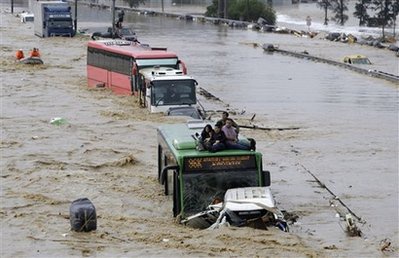Istanbul flash flood 2009

Flash floods associated with intense and prolonged rainstorms are a common phenomenon, especially in coastal parts of Turkey.
The Marmara region in north-western Turkey suffered from a series of floods during 7–10 September 2009, with 32 human losses and more than $100 million of economic damage. The flash floods were due to intense rain storms that swept the region, amounting to its heaviest rainfall in decades. The 24-h rainfall amounts varied between 100 and 253 mm during the flooding period. Additional factors such as land use changes, urbanization, poor drainage, and construction and settling in the flood-prone areas worsened consequences of the floods, especially in major urban areas of the region. Istanbul, the largest city of Turkey with 14 million inhabitants, suffered most from the flash floods. The floods submerged some suburban districts of the city and the city’s highways turned into rivers and transportation and communication infrastructures were damaged. A total of 35,000 people were affected by the floods in the Marmara region.
Istanbul historically has been vulnerable to natural disasters. Since 1967, the city suffered 13 major floods. The city has grown rapidly over the last 40 years due to internal migration. In order to absorb the increasing population, new settlements have been built, mostly illegally on the outskirts of the city. The rapid urbanization led people to occupy flood plains to open up new spaces for development. Natural hydrologic pattern of the city changed considerably due to expansion in the transportation network and more impervious surface were added to the city’s land use. Flood control structures and channel improvements in creeks were not able to accommodate the increasing urban pressure resulted expansion of the settlements and industrial sites due to internal migration. Capacity of the storm sewers and flood detention structures in the city remained inadequate to control a large flood as in case of the September 2009 flood and consequences were devastating. Infrastructure in the newly established residential and commercial areas of the city did not grow in parallel to the population, and therefore, the current infrastructure of the city is not adequate even to accommodate runoff from a moderate rainfall.
Disastrous flood events are inevitable in Istanbul in the future unless necessary measures are taken by the local governments and authorities:
- An initial step should be developing a comprehensive flood mitigation plan within a framework of integrated flood plain management. Flood inundations maps should be prepared, based on different recurrence intervals and zones under risk of flooding, before taking any structural measures.
- Once the risk areas prone to floods are identified, further development in those known flood risk areas should be prevented by enforcing specific building codes. In particular, no construction activities should be allowed in the flood zones of rivers which are exposed to high risk of flooding.
- Present industrial facilities and residential buildings in flood zones of Ayamama and Kağıthane Rivers should be relocated to other parts of the city where the risk of flooding is lower or non-existent.
- Some structural measures also should be taken to control the flows in main rivers of the city, especially the Ayamama and Kağıthane Rivers which frequently overflows following intense rainfalls.
- A more important step would be setting up flash flood early warning system to monitor water levels in the main creeks in and around Istanbul, monitor and assess spatial and temporal distribution of rainfall, and issue warning when necessary to act promptly to evacuate the areas where there is risk of being flooded.
The proposed measures will not be successful unless they are supported by legislative measures including specific building codes for flood-prone areas, political efforts, and public awareness to enhance their effectiveness.
Source: Kömüşcü and Ҫelik (2012). Natural Hazards. Published online 27 December 2012.
Photo: unknown (www.flickr.com)



